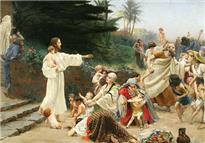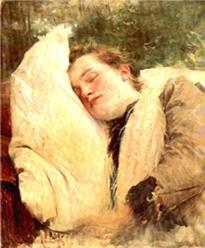Vlaho Bukovac was born in Cavtat, Croatia, lived in America, Paris, Zagreb and Prague, and spent extended periods in England and Vienna. Wherever talented painter Vlaho Bukovac (1855-1922) settled, he soon enjoyed fame and recognition.
Wherever talented painter Vlaho Bukovac (1855-1922) settled, he soon enjoyed fame and recognition. He staged successful exhibitions at several Paris Salons, the first Vienna Secession exhibition, the second and fourth Venice Biennale and the Paris World Exposition in 1900. This winter, Gemeentemuseum Den Haag is to stage a major retrospective of the glittering career of this versatile painter, whose work has never before been shown in the Netherlands.
Vlaho Bukovac’s life reads like a boy’s adventure story. In his youth, his life took him to many places, and he did a huge variety of jobs, including deckhand, photographer’s assistant and even waiter. Once his unique talent for painting became apparent, however, he was soon able to live from portrait painting, and he was one of the few Slavonic artists to study at the École des Beaux Arts under the famous Alexandre Cabanel. He was 22 at the time, and this marked the beginning of a sparkling career.
The 1882 Salon was a real triumph for Bukovac. He showed La Grande Iza, a nude portrait of a coquettish Parisian woman, the heroine of a popular novel. This sensual, flesh-and-blood woman drew so much admiration that newspaper vendors cried his name on the boulevards of Paris. Bukovac’s success was not limited to France, however. He also managed to break through in Britain, with the help of Vicars Brothers of London.
Although, with his perfect mastery of academic painting, Bukovac was a highly valued member of the official art establishment, he was also inspired by the modern Impressionist artists who showed their work in small galleries. That influence can be seen in the expressive touch and Pointillist technique he gradually adopted. Besides landscapes, Bukovac mainly painted portraits. He constantly discovered new possibilities within the genre, having his models pose in costume, alone, naked or in groups, and in everyday, allegorical, symbolic or religious settings. Again and again, he succeeded in depicting people as they really were. Lovers, friends, acquaintances, public figures or himself: every time he managed to expose the personality in the painting. Character, origin, age, status and state of health can all be seen in his portraits.
Throughout his wanderings and his extended stay in Paris, the land of his birth continued to draw Bukovac. In 1893 his dream of breathing new life into the cultural scene in Croatia took him to Zagreb. He managed to persuade other successful artists to re-establish themselves in their home country, too, creating an active, flourishing cultural centre from which Bukovac also benefited. The group he gathered around him, with their sunny paintings depicting Mediterranean subjects, soon became known abroad as ‘The Colourful School of Zagreb’.
In 1894 Bukovac produced the large painting Gundulic’s Dream, based on the epic patriotic poem Osman by Ivan Gundulic, which describes the contrasts between Christianity and Islam, and Eastern and Western Europe – an issue that was as topical then as it is today. This established his name both at home and throughout Europe, thanks to the painting’s success at the Venice Biennale. Having illustrated the ‘nation’s favourite song’, he soon came to be regarded as the pride of Croatia.
Our recomandation is to visit permanent collection in Bukovac’s childhood home located on one of the little streets that leads from the Cavtat shore towards Prijeko Street.
The Bukovac House, as part of the Museums and Galleries of Konavale, was reopened to the public in 2004.
KUĆA BUKOVAC
Bukovčeva 5
20210 Cavtat
pho. +385 (0)20 478 646
fax. +385 (0)20 478 646
http://www.kuca-bukovac.hr
muzej@kuca-bukovac.hr
Working hours:
From November 1st to April 30th:
Tuesday to Saturday:
9 am to 1 pm, 2 pm to 5 pm
On Sundays: 2 pm to 5 pm
From May 1st to October 31st:
Tusday to Saturday:
9 am to 1 pm, 4 pm to 8 pm
On Sundays: 4 pm to 8 pm
Closed on Mondays.
|
|
|







